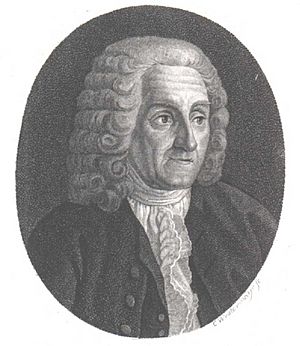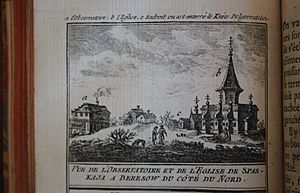Joseph-Nicolas Delisle facts for kids
Quick facts for kids
Joseph-Nicolas Delisle
|
|
|---|---|
 |
|
| Born | 4 April 1688 Paris
|
| Died | 11 September 1768 (aged 80) Paris
|
| Nationality | French |
| Known for | Delisle scale |
| Scientific career | |
| Fields | Astronomy Mathematics |
| Doctoral advisor | Jacques Cassini |
| Doctoral students | Johann Hennert Jérôme Lalande |
Joseph-Nicolas Delisle (born April 4, 1688 – died September 11, 1768) was a famous French astronomer and mapmaker. He is best known for creating the Delisle scale, which is a way to measure temperature. He invented this scale in 1732.
Contents
Who Was Joseph-Nicolas Delisle?
Joseph-Nicolas Delisle was born in Paris, France. He was one of 11 sons in his family. His father, Claude Delisle, was also a well-known mapmaker. Joseph first studied classic subjects, but soon became very interested in astronomy. He learned from famous astronomers like Jacques Cassini.
Early Career and Discoveries
In 1714, Delisle joined the French Academy of Sciences, which is a group of top scientists. The next year, he made an important discovery. He observed a bright spot in the middle of a shadow, which was later called the Arago spot. Even though he was a talented scientist, he didn't have much money at first.
In 1712, he set up his own place to study stars, called an observatory, at the Luxembourg Palace. He later moved it to the Hotel de Taranne. From 1719 to 1722, he worked at the Royal Observatory. In 1724, he met the English astronomer Edmond Halley in London. They talked about many things, including the transit of Venus, which is when Venus passes in front of the Sun.
Journey to Russia and Return to Paris
Delisle's life changed a lot in 1725. The Russian ruler, Peter the Great, invited him to Saint Petersburg. Peter wanted Delisle to start and lead a school for astronomy there. Delisle arrived in Russia in 1726, after Peter the Great had passed away.
In Russia, Delisle became very rich and famous. He helped create maps of the northern Pacific Ocean, which were used by explorer Vitus Bering. When Delisle returned to Paris in 1747, he was so well-known that he built a new observatory. This observatory was at the Cluny palace and later became famous because of another astronomer, Charles Messier. Delisle also received the special title of Astronomer from the Academy.
Later Life and Important Work
Delisle was recognized by many scientific groups. He became a member of the Royal Society in London in 1725. In 1749, he joined the Royal Swedish Academy of Sciences.
In 1760, Delisle suggested a big idea. He wanted scientists from all over the world to work together. Their goal was to watch the 1761 Transit of Venus at the same time. By doing this, they hoped to figure out the exact distance between Earth and the Sun. He even made a map showing where on Earth people could best see this event. However, the Seven Years' War made it hard for scientists to travel and work together. Delisle retired in 1763 and passed away in Paris in 1768.
Expedition to Siberia
In 1740, Delisle went on a long journey to Siberia. His main goal was to watch the planet Mercury pass in front of the Sun from a place called Beryozovo.
The Journey and Missed Observation
Delisle and his team left Saint Petersburg on February 28, 1740. They traveled through Moscow and other cities before reaching Beryozovo on April 9. However, on April 22, the day Mercury was supposed to cross the Sun, the sky was covered with clouds. Because of this, Delisle could not make his important astronomical observations. He returned to Saint Petersburg on December 29, 1740.
Other Scientific Discoveries
Even though he missed the Mercury transit, Delisle made many other interesting observations during his trip. He recorded information about birds, plants, animals like the Siberian beaver, and the geography of the land.
In his travel writings, Delisle also described the native people he met, such as the Votyaks and Tartars. He wrote about their beliefs, customs, what they ate, and how they dressed. He even planned to write a full study about the people of Siberia. He had a detailed list of what information to collect about each group, including their history, where they lived, their government, religion, and language.
Delisle's Collection of Curiosities
Delisle loved collecting interesting items. On June 30, 1740, he visited a monastery in Tobolsk. There, he saw old manuscripts and huge bones, including a mammoth tusk. He learned about a merchant who found a complete mammoth head.
During his Siberian journey, Delisle added many unique things to his own "cabinet de curiosité" (a collection of rare and interesting objects). He brought back copies of old writings, mammoth bones, and various other items. These included parts of traditional clothing, a Samoyed arrow holder, a bark bucket, rare stones, and special pottery.
The Atlas Rossicus Map Project
The idea for a map of the Russian Empire started with Peter the Great. However, it took twenty more years to actually happen. Ivan Kirilov, the first head of the imperial map office, invited Delisle to Russia to help with this big map project.
Challenges in Mapmaking
Delisle and Kirilov had different ideas about how to make the maps. Delisle wanted to use astronomy to find exact points on the Earth, which took a lot of time. Kirilov preferred to map based on natural features first, and then adjust them using astronomical points.
Kirilov published some maps using his own methods, but he asked Delisle for advice. After Kirilov's death in 1737, the project slowed down. It wasn't until 1745 that the Academy in Saint Petersburg finally published a complete map collection called Atlas Rossicus. It was printed in Latin and Russian.
Delisle's Role and Legacy
Delisle worked on the atlas in the 1730s. However, his very strict scientific approach made the project move slowly. Because of this, he was removed from the team in charge of the atlas in 1740. Some even accused him of sending secret documents to France.
Delisle felt alone at court and asked to leave Russia in 1743. He was allowed to go four years later. Even though he was removed from the project, the Atlas Rossicus was still published under his name. Some historians debate how much credit he deserves. However, experts like Marie-Anne Chabin believe that Joseph-Nicolas Delisle should be seen as the main person behind this important map collection.
What Is Delisle Remembered For?
Joseph-Nicolas Delisle is most famous for the Delisle scale, the temperature scale he created in 1732. This scale measures temperature differently than the Celsius or Fahrenheit scales we use today.
To honor his contributions to science, a crater on the Moon is named after him. Also, an asteroid in space, called 12742 Delisle, carries his name.


